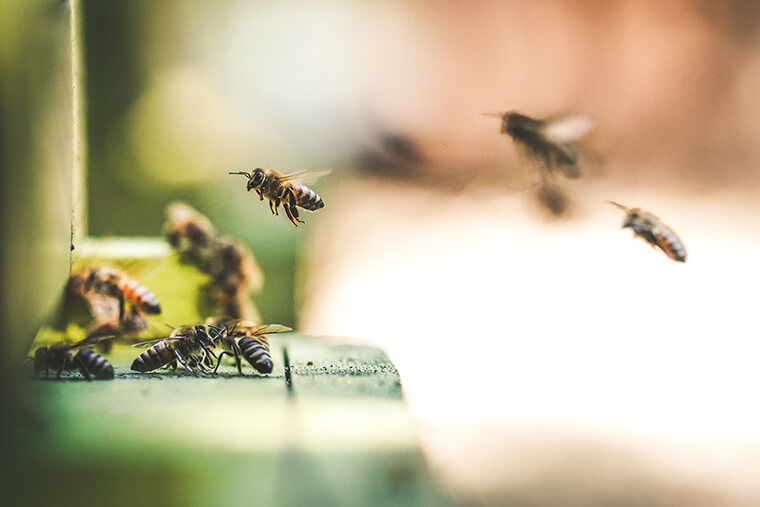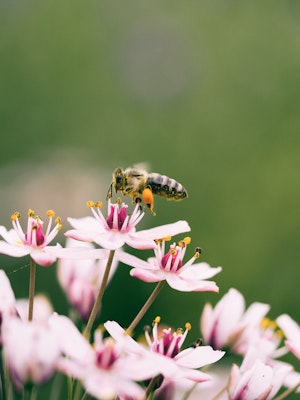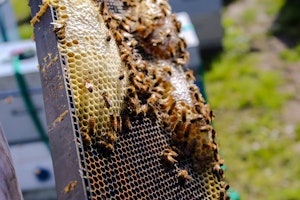 Back to the Be Inspired Blog
Back to the Be Inspired Blog

How to Attract Bees to Your Garden
Bees are one of the most important insects in the world; they are responsible for just about all of our natural food, crops and even jobs.
Why Do We Need Bees?
Here are some fast facts about honey bees courtesy of HoneyLove:
- Bees pollinate 80% of the world’s plants including 90 different food crops.
- 1 out of every 3 or 4 bites of food you eat is thanks to bees.
- The honey bee is responsible for $15 billion in U.S. agricultural crops each year.
- Honey is the only food that does not spoil (bacteria can’t grow in it, and because of its low moisture content and low pH – honey can last indefinitely).
- Bees maintain a temperature of 92-93 degrees Fahrenheit in their central brood nest regardless of whether the outside temperature is 110 or -40 degrees.
- The honey bee is the only insect that produces food eaten by man.
- Man’s first alcoholic beverage, mead, is a wine made with honey.
A popular quote attributed to Albert Einstein declares, “If the bee disappeared off the face of the Earth, man would only have four years left to live.” While that is a startling statement, unfortunately we may be closer to it than we’ve ever been before. Scientists are having a hard time pinpointing why bees are disappearing and dying off.
Why Are Bees Disappearing?
Here are a few theories from Green and Growing that may explain why bees are fading out:
- Insecticides pose a risk to pollinators: It’s all in the name: insecticides are chemicals meant to kill insects. They are widely used in in farms, affecting cropland areas everywhere. In the current chemical-intensive agriculture system, scientists are increasingly convinced that some insecticides are cause for negative effects on the health of pollinators.
- Parasites and pathogens infest and kill hives: Many of the hives that died because of Colony Collapse Disorder (CCD) were found to have varroa mites. Thought to be rare, these tiny parasites now infest bee hives all over the world. They are responsible for causing two types of problems.
- The mites attach to the bees’ bodies and suck out their fluids. This weakens the bees and puts a strain on their immune systems.
- The mite’s bite results in an open wound, a perfect gateway for the viruses to get in. This mix of viral infection and a compromised immune system can lead to a lethal end.
- Poor Nutrition: The thing that can keep bees going is good food. Unfortunately, given the growing number of one-crop farmlands, bees don’t get the pollen from the wide variety of plants they need for a healthy diet. In smaller crops, bees have enough time to forage for pollens in varied fields, which keeps them healthy.
- Climate Change: Scientists believe that climate change is responsible for the death and disappearance of many bees; weather events, changes in rainfall patterns and increasing temperatures are all factors that will impact pollinator populations.
HoneyLove also offers theories on threats to bees that include:
- Colony Collapse Disorder:Over the last three years, more than 1 in 3 honeybee colonies has died nationwide. After WWII, there were 5 million honeybee colonies and now there are only half that many.
- Pests:Threats to the bee are Wax Moths, Varroa Mites, Tracheal Mites, American Foulbrood, Colony Collapse Disorder.
- Fear of bees:HoneyLove also offered a theory from Just Food: “The most common concern about honeybees is bee stings. Honeybees are not aggressive by nature and are unlikely to sting. Only 0.4% of Americans report an allergy to insect stings in the U.S., and almost none of these are caused by honeybees. In addition, less than 1% of the US population is at risk of systemic reaction to stings by honeybees. Severe reactions from the sting of any one insect in a year are 1 in 5,555,556. The chance that someone will be hit by a car is 59.3% higher.”
What Can You Do for Bees? 
Gardeners know the importance of bees and that they’re not just insects to run away from. Keep reading for tips on how to attract bees to your garden, what to plant and more. Also, if you don’t live in a home with a giant garden or open spaces, check out our blog post on Starting an Urban Beehive.
Aside from growing specific flowers (we’ll cover that below) there are ways you can make a bee-friendly garden. Here are a few tips from the Garden Club at Home Depot:
- Downsize Your Lawn. Lawns don’t have to be sterile carpets of grass. Consider leaving part of your lawn natural or plant shrubs and trees. Here’s a bonus too: you get a break from all that mowing.
- Provide Water.Did you know that bees need drinking water? They’ll visit a shallow birdbath or other water feature, or take sips of water from sprinklers or irrigation systems that you use in your garden.
- Build a Bee Box.Although honeybees live in their hives, many wild bees take refuge in dead trees or branches, weedy hedgerows, abandoned animal burrows, or underground nests. Think about leaving a portion of your yard untended for them. Mason bees, which are particularly useful for pollinating fruit trees, seek holes in dead wood left by beetles and other insects. Are you interested in making your own bee box? Check out the instructions here. To get the best use out of your bee box, Home Depot recommends facing the box east or south since bees require the warmth of the sun; install your box three to five feet about the ground. You can also make many boxes for different locations in your yard. You should avoid using insecticides around the bees and clean out the box once a year with some water and a little bleach.
- Use Organic-Approved Pesticides. Avoid using harsh chemicals around your plants that attract bees. Remember to always read the label on your product to learn the safest way to use them. Whenever possible, use non-toxic insecticides, pest barriers and repellents.
Are you looking for even more tips to attract bees to your garden? Here are a few more tips from The Spruce:
- Use local native plants. Research shows that native plants are four times more attractive to native bees over exotic flowers. They are also usually well adapted to your growing conditions and can thrive with minimal attention. In gardens, heirloom varieties of herbs and perennials can also provide good foraging. Some of SummerWinds’ favorite native plants include:
- Toyon,Heteromeles arbutifolia: This summer blooming tree is not only lovely, but the bees go crazy for it. It berries in the winter and is very showy. Robins are drawn to it as well, and it grows to 15 feet wide by 15 feet tall.
- Redflower Currant,Ribes sanguineum: This plant offers fast-growing beautiful long pink flowers that attract hummingbirds and native bees. They host long miniature clusters of currents and can grow 8 feet wide by 8 feet tall.
- Deer Grass,Muhlenbergia rigens: This native grass can live 75 – 100 years and will maintain its green bunch in winter. Tall flower spikes bloom in late spring and will hold on until winter. The summer color of the grass is part golden and part green.
- Giant Chain Fern,Woodwardia firmbriata: This is the largest fern in North America. It has long fronds that can reach to 8 feet in length and, lending to its name, it has a chain shape visible on both sides. This fern typically grows 6 feet tall and 6 feet wide.
- Toyon,Heteromeles arbutifolia: This summer blooming tree is not only lovely, but the bees go crazy for it. It berries in the winter and is very showy. Robins are drawn to it as well, and it grows to 15 feet wide by 15 feet tall.
- Have a number of different-colored flowers. Bees have great color vision to help them find flowers and the nectar and the pollen they offer. Flower colors that particularly attract bees are blue, purple, violet, white and yellow.
- Plant your flowers in clumps. Flowers planted in clusters and clumps of one species will attract more pollinators than individual plants scattered through the garden. If the space allows, make the clumps four feet or more in diameter.
- Include flowers of different shapes. There are thousands of different species of bees in North America and they come in all different sizes, have different tongue lengths and will feed on different shaped flowers.
- Have a diversity of plants flowering all season. Most bee species are generalists; they feed on a range of plants throughout their life cycle. By having a number of plant species flowering at once, and a sequence of plants flowering through spring, summer and fall, you can support a range of bee species that fly at different times of the year.
What to Plant for Bees 
If you want to help pollination and attract bees, plant these in your garden:
- Alyssum
- Agastache (anise hyssop)
- Asclepias (butterfly weed)
- Aster
- Echinacea (coneflower)
- Geranium (cranesbill)
- Monarda (bee balm)
- Papaver (poppies)
- Rudbeckia (black-eyed Susan)
- Trifolium (clover)
There is so much gardeners can do to protect bees and it starts in your own garden. Contact us today to for additional tips and tricks making your garden bee friendly!

